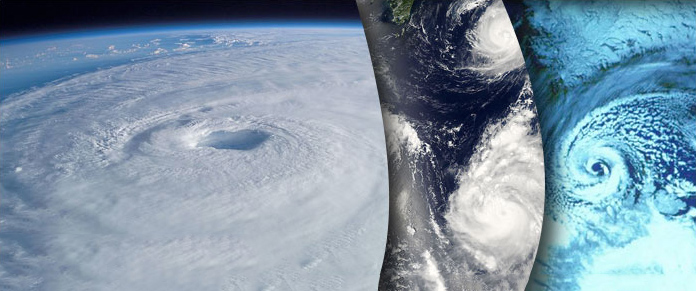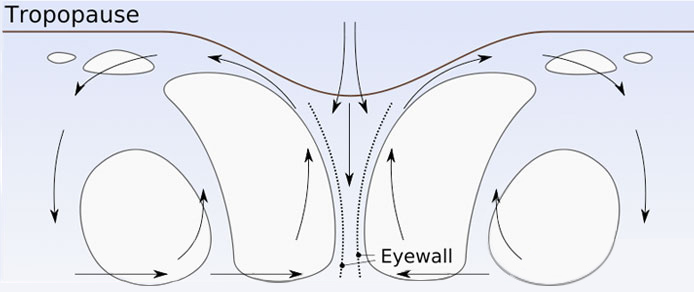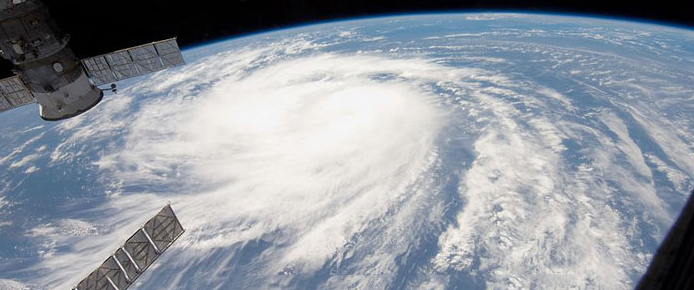Tropical Storms
So far 2011 has been a very busy Tropical Storm year – how will it end – will there be a disaster?
Hurricanes, cyclones and typhoons are all local names for tropical storms. In the Atlantic and Caribbean Oceans and around the Americas they are called hurricanes. Around China and east Asia they are called typhoons and around India, Bangladesh and Myanmar they are called cyclones. A lot of scientists predict that if climate changes causes the oceans to warm up that there will be more tropical storms and also stronger tropical storms – not a nice thought.

Hurricanes, Cyclones and Typhoons
Tropical storms form over warm oceans; the heat and moisture of the warm ocean provides the energy to make the storm. Surface temperatures usually need to be above 26.5°c for a tropical storm to develop.
What causes them?
The heat from the ocean surface provides energy to warm the overlying air. It also provides a lot of water vapour which is absorbed by the air. The heat warming the air causes it to rise; this will continue as long as the air stays over the warm water.
As the air rises, it cools and water vapour condenses to form clouds. When it changes from a gas back to a liquid it releases the energy it absorbed when it evaporated back into the surrounding air as heat. This means that the air gets a second heating and rises again even higher high within the atmosphere.
As long as our newly forming storm stays over warm oceans it has a constant source of heat and water vapour – the two fuels that the storm needs to make it into a hurricane strength storm. Storm strength is measured on the Saffir-Simpson hurricane scale.
As the air rises air pressure drops, and surrounding air rushes in to take its place this causes the strong winds. Because the Earth is spinning the wind rushes in a spiral and this can be seen from space because it makes the clouds into a spiral shape too. The winds blow around a central still area called the eye of the storm. The most destructive winds are close around the eye in a zone called the ‘eye wall’.

Hurricane Formation
The low air pressure means that the sea level rises because there is less air pressing down on the surface; add this to high waves caused by the winds and we get very high sea levels called a storm surge. This is often the most dangerous part of a tropical storm. The final major hazard is high levels of rainfall from all of that cloud. This often causes flooding and landslides.
Saffir-Simpson Scale
Is a scale used to measure tropical storms. Storms are put into one of five categories with one being the lowest and five being the highest. Scientists use the sustained wind speed, surface air pressure and size of storm surge to decide which category a storm is in.
| Category | Maximum Sustained Wind Speed mph | Minimum Surface Air Pressure mb | Storm Surge m |
| 1 | 74-96 | 980 | 1.0-1.7 |
| 2 | 97-111 | 979-965 | 1.8-2.6 |
| 3 | 112-131 | 964-945 | 2.7-3.8 |
| 4 | 132-155 | 944-920 | 3.9-5.6 |
| 5 | 156+ | 920 | 5.7+ |
Air pressure is the effect of the weight of a column of air pushing down on the surface of the Earth. If air is descending air pressure is higher than if air is rising. Wind is air moving from areas of high pressure to areas of low pressure.
Storms so far in 2011
By the time you are reading this there could well have been more tropical storms as the season lasts as long as there is warm enough water on the surface of the oceans. Normally in the Atlantic until late November. So far though the storms have given us a scare with Hurricane Katia threatening the world’s most important centre of trade – New York. Large areas had to be evacuated and the city was shut down in cased the storm surge hit the city and caused a global catastrophe.

Hurricane Katia
Though the Atlantic Hurricanes seem to always get the headlines there are far more Typhoons hitting the Western Pacific with the Phillipines regularly getting 20 or more hits per year. However the most dangerous storms are usually the cyclones which hit Bangladesh and Myanmar. This is because both areas have very low landscapes so the storm surges can push far inland possibly drowning tens of thousands of people.
Activity
1. Draw a flowchart, showing how a storm is formed
2. Search for recent storms this year such as hurricane Katia and Typhoon Roke. Compare their impacts with some big recent storms such as Hurricane Katrina and Cyclone Nargis. Write an article for a newspaper or TV report to try to raise awareness of the dangers of these storms and why they might be getting stronger and more frequent as a result of climate change.

